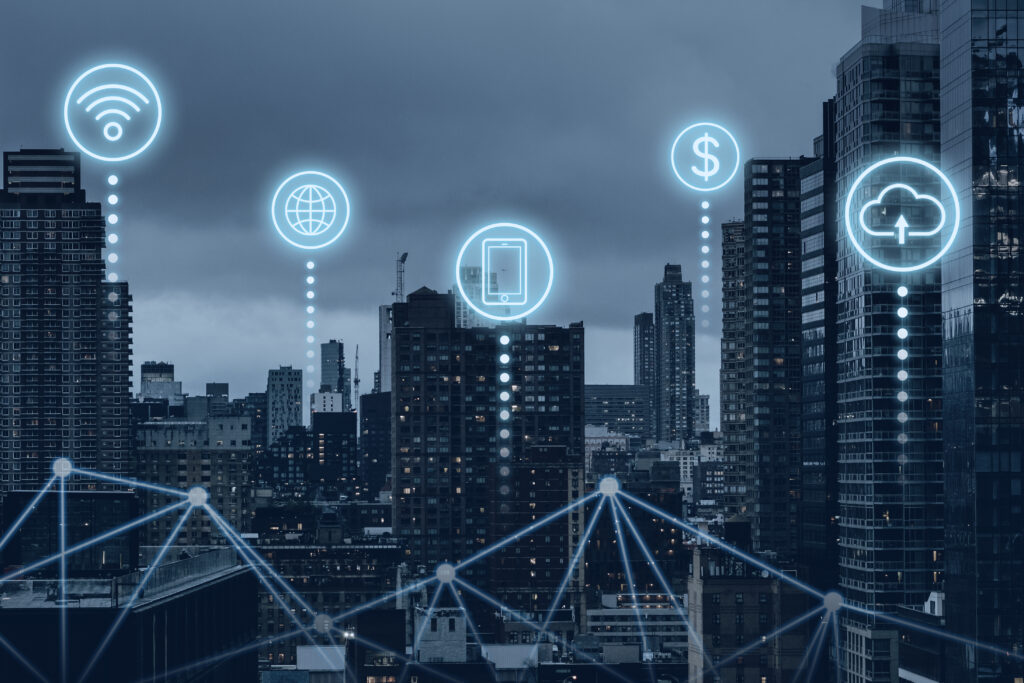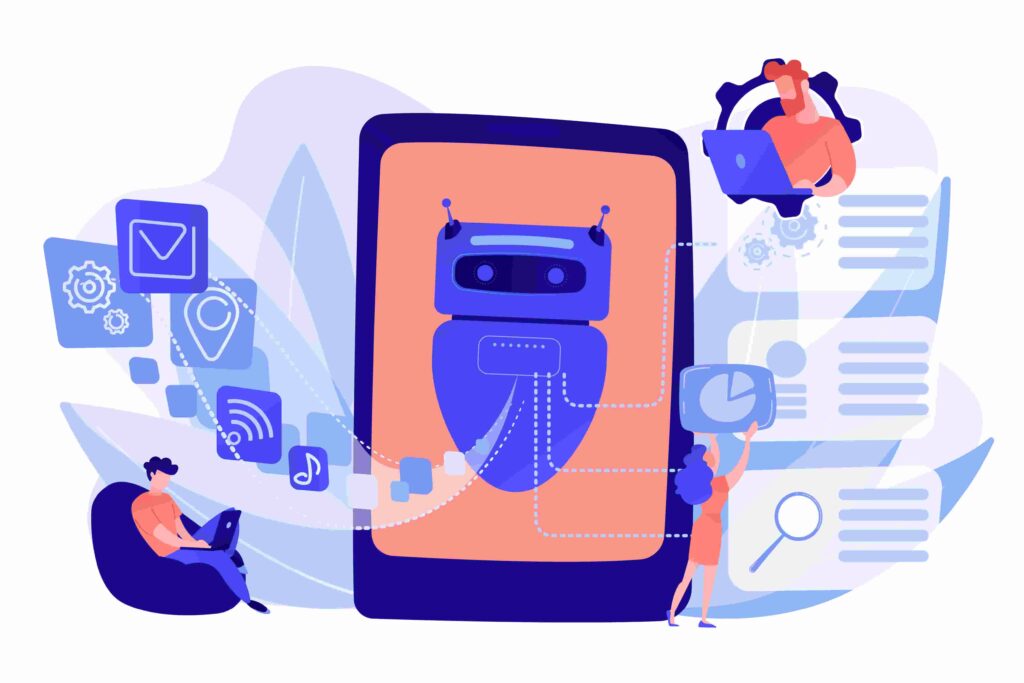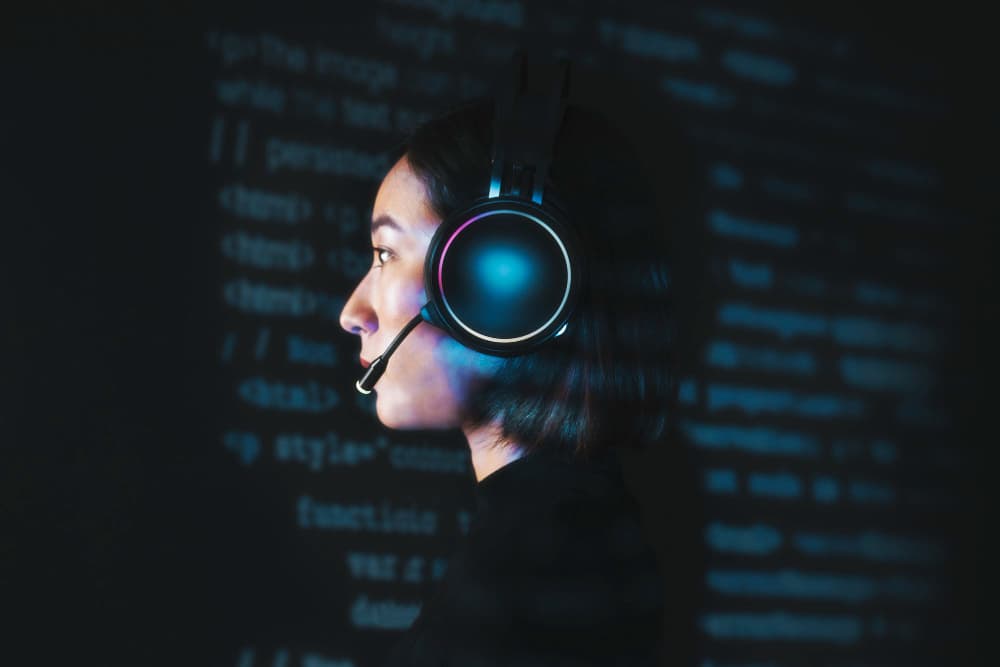Internet of Things (IoT), is the connection of common objects to the Internet, expanding its functionalities and bringing countless possibilities to the day by day of human beings.
Today, with the digital transformation, we have access to a gigantic volume of information. With this, new functions are inserted in people’s routine, completely changing the behavior or the way of performing certain activities.
Want an example?
Years ago, people communicated by letter. Then came the landline, then the cell phone and e-mail. And, of course, many other evolutions after that, such as SMS, chats and video conferences.
With the IoT concept, people will soon be able to communicate through virtual reality glasses, for example, “visiting” the person they are talking to, as if they were face to face. Everything virtually.
The internet of things is a technological innovation that has been growing exponentially and is already part of people’s lives, in many aspects.
The basic principle of the internet of things is to provide to the user functionalities that the internet offers, without needing a computer or cell phone to do so (surely you’ve seen someone using a watch – the smartwatch – to consult the daily agenda, right?) .
Got confused? Do not worry! We will explain everything about what IoT is and how this concept is slowly becoming part of your daily life. In this article, you will learn:
- What is the Internet of Things (IoT)?
- How did the Internet of Things come about?
- What is the purpose of the Internet of Things (IoT)?
- How does IoT works?
- Examples of Internet of Things
- How to prepare for the digital transformation
Enjoy your reading !
What is the Internet of Things (IoT)?
Internet of Things, also known as IoT, is a concept that describes the connection between common objects with the internet.
In other words: it’s not just computers that are able to connect to the virtual world. You may have known this for a few years, since your first smartphone.
The truth is that the evolution of the internet of things has made it possible to connect many common objects in people’s daily lives to the internet. This evolution is increasing the functionality of these objects, making them more and more necessary.
Virtual assistants, cars and smart buildings are some examples. The speed with which these new creations appear is so great that it is not even possible to predict what the next releases will be.
It is quite possible that in the next 5 or 10 years, there will be professions and objects with functions that we do not yet know or imagine.
In this way, the internet of things is a reality to many people, in a greater or lesser extent. In addition, it offers an incredible opportunity for companies to think outside the box. For organizations, it has never been more necessary to cultivate a culture of innovation than it is now, opening the way for inventive creativity.
Want to know more about this concept? Check this out:
Concept
Although it is common to associate the term IoT with obvious equipments (such as smart TVs or smartphones), the concept of the Internet of Things involves less likely wearables.
A wearable is a “wearable device”, that is, common objects for personal use, which feature embedded technology, such as watches, sneakers, clothing or glasses.
The IoT concept is also applied to homes or vehicles, as machines such as refrigerators as well, blenders or even robots for residential, commercial or industrial use.
So, the main objective and functionality of the internet of things is therefore, to connect daily use objects to the internet, giving them a broader functionality, with more intelligence and greater capacity for integration with other sources of information.
The basic idea is to unite the physical world with the digital, making equipment communicate with each other, transforming people’s lives in many ways.
Internet of Things and Artificial Intelligence
Another concept being widely discussed is artificial intelligence (AI). Despite being correlated, AI and IoT are not the same thing.
Objects with embedded technology for internet connection can also bring artificial intelligence functionalities to optimize their activities and to facilitate people’s routine.
This is the case of virtual assistants, such as Alexa, a secretary offered by Amazon. The speaker recognizes the voice, understands the request and delivers exactly what was asked (ok, sometimes not exactly).
How did the Internet of Things come about?
You may be impressed, but even though the term IoT is more often used these days, the concept emerged in the 1990s. Since then, has been a lot of technological evolution (remember all the cell phone versions and models you’ve had in this period).
In 1991, when the internet started to become popular, mainly in the USA, discussions about connecting objects to the network began. However, it was almost at the end of the decade that the concept of IoT officially emerged.
Who invented the Internet of Things?
In 1999, Kevin Ashton of the Massachusetts Institute of Technology, recommended the use of the term Internet of Things to describe the idea of connecting objects to the Internet.
For the specialist, the internet of things would be able to reduce, optimize and save energy and natural resources, since the volume of data collected by the technology could anticipate movements and behavior, adjusting its functions for better performance.
Internet of Things in Brazil
In Brazil, 70% of the population is already connected and it is estimated that there will be more than 724 million devices connected by 2022.
With this, the Federal Government is already aware of the potential of IoT in the development and economic growth of the country. The Ministry of Science, Technology, Innovation and Communications (MSTIC) worked on the elaboration of a National Plan for IoT.
As a result, we have the Decree No. 9,894, of June 25, 2019, which:
It institutes the National Internet of Things Plan and provides to the Management Chamber and Monitoring of the Development of Machine-to-Machine Communication Systems and the Internet of Things.
It is estimated that the internet of things will enable productivity growth, adding R$ 122 billion to the national GDP by 2025, in addition to generating 1.9 to 2.6 million new jobs.
Therefore, it is important that the population is aware of the progress of this project, encouraging development and seeking, within their companies and their community, to open borders for innovation.
What is the purpose of the Internet of Things (IoT)?
The internet of things aims to transform people’s lives, making their routines simpler and more effective.
With the communication between equipment and objects, it will be possible to anticipate situations or needs. For example, through the volume of data captured, professionals will be able to find solutions to revert environmental problems, cure for serious illnesses and much more.
Another important result is a little contradictory: with the objects around us being part of our lives, facilitating our daily lives, people will be able to focus more on real connections, making more use of their time and achieving a better quality of life.
So don’t think that IoT, artificial intelligence or other new age concepts will end human contact between people. On the contrary: the trend is that the more technology is part of our lives, the more we will rescue our old values.
How does IoT work?
Now that we know that the internet of things is the connection between objects and the internet, let’s better understand how this process works.
In summary, there are three indispensable factors that make this technology work. Are they:
network: is the mean of communication, such as Wi-Fi, 4G, 5G, bluetooth, among others;
device: are the objects or wearables that will be connected. They must be equipped with items that allow connection to the network, such as chips, antennas or sensors;
control system: used to capture and process all data, being also responsible for new connections from this data.
Internet of Things on day by day
Have you ever imagined a refrigerator that notifies you when a certain food is ending, and already offers a list of locations and prices for that item? Also imagine that you can make your shopping list and send it to the supermarket, all through this same equipment.
It would be amazing, wouldn’t it?
Now, imagine that your alarm clock goes off and, from the sound of the alarm, your curtains automatically open, your coffeemaker starts working and your clothes closet suggests the look of the day, according to the weather forecast for the next hours.
It sounds like a science fiction story, but there are already countless objects that make your daily life easier and much more is yet to come. The so-called “smart homes” are already being built and their concept is being applied more widely.
The idea is that in the next years, smart cities will start using IoT to control mobility, security and even public transport.
Internet of Things and its application in education
The internet of things plays an important role in education. This happens because the new generations, born in the digital age, no longer adapt to outdated teaching models.
In addition to being used for student safety (with devices that inform parents about entry and exit, for example), the IoT can help teachers create smarter lesson plans based on survey data and consumed content by the students.
With objects and technologies present in the school routine, students will be able to be more interested and turn their attention to the subjects they are working on. Not to mention that other technologies, such as augmented reality, will take studies to a new level, enabling an even better use.
Examples of Internet of Things
If it is still not clear what the internet of things is or what the objects involved are, we list below some examples that are already a reality in the routine of many people and companies:
Hospitals can have devices connected to patients, sending real-time data such as heart rate, blood pressure and oxygenation.
Agriculture can use sensors to measure the temperature and humidity of the land or report on the probability of rain, helping producers to control crops.
Factories can use IoT to measure the productivity of equipment, advise managers about the need for maintenance or purchase of supplies and expansion of the manufacturing plant.
Stores and supermarkets can count on intelligent shelves, which inform when the minimum stock of a given product is being reached, in addition to informing about products with less output or near expiration, helping in taking actions such as repositioning, promotions and others.
Smart buildings and interior design can use IoT to bring automation into homes, with facial recognition sensors for opening gates or curtains, lighting and appliances activated by voice control or smartphones.
Autonomous vehicles are already being tested and used in some parts of the world, using artificial intelligence and connected devices to ensure mobility, safety and comfort for passengers.
How to prepare for the digital transformation
Digital transformation is happening all around us. And if companies want to stay in the market, they need to be prepared and willing to follow this evolution.
With the new digital age, consumers are more demanding, the volume of available information is very large and a company’s main competitor may be on the other side of the world. Going ahead, with innovations and new technologies embedded in products and services, is already an important competitive advantage.
To help in this transformation process, below are 5 tips that can be implemented in your company. Check it out:
-
Automate processes
We can’t talk about embracing digital transformation in our companies without doing at least the basics, right? Try to automate your company’s processes and take any repetitive and operational tasks out of the routine.
With this, professionals will have more time to dedicate to strategic and creative activities. This creative space is a key to the emergence of innovations.
-
Perform analysis of your digital presence
How is your company positioning itself on the internet? Do you already use technology as a work tool?
If you believe that having a website and a page on some social network is enough, you are wrong – and quite late!
There are several systems that support, in a very significant way, service operations, sales, support and much more. Artificial intelligence and augmented reality are already some of the main concepts in many companies, in different sectors.
Therefore, assess your digital presence and seek to make the most of this rich and intense environment that is the internet!
-
Develop a culture of innovation
To keep up with constant changes, thanks to the fast evolution of technology, the company needs a culture of innovation. What does that mean?
Your company must make room for new ideas, sparking discussions and encouraging the creativity of all your employees.
A culture of innovation involves being open to change, participating in events, fostering the exchange of knowledge and experiences in addition to getting closer to companies and people who share the same thinking, such as universities, startups and incubators.
-
Plan, test, evolve
One of the lessons learned for those who implement a culture of innovation is to understand that the timing for new changes in the company is getting smaller.
However, this does not mean that you should be producing new products or investing in equipment without planning; but it means that the strategic planning models of yesteryear no longer apply.
The concept of MVP (minimum viable product) and others such as design thinking and lean design are fundamental to this new era. The planning must be done in a simplified way, using frameworks, and the new product or service must be prototyped, so that tests are carried out as quickly as possible.
With the tests, the company can validate the feasibility of the development, evolve the model and put it on the market.
-
Use the data
Likewise, to keep up with technological developments, the use of data is essential. With the internet, we have a huge volume of data generated daily, which can support strategic decisions.
Until 2016, 90% of the data generated by the Internet of Things were not analyzed by companies and, believe it or not, this reality has changed very little so far.
Concepts such as big data are increasingly being observed. Then, the opportunities for statisticians (or even IT professionals) are huge!
Therefore, it is up to companies to know how to take advantage of this ocean of available information, using it to create competitive advantages, in order to stay ahead.
Conclusion
The internet of things is a concept increasingly present in people’s routine. With fast evolution, it’s almost impossible to predict how far it might go.
Therefore, companies need to be tuned in and open to new opportunities and innovations, seeking in the creativity of their employees and events about technology, the answers to the continuity of their business.
It is certain that projects stopped in time will no longer have many years of life in the future. So, if you haven’t embraced a culture of innovation or applied digital transformation in your company yet, it’s time to get started.
For this, it is not necessary great discoveries or inventions. Start by looking at your IT department – they have a lot of responsibility in this process, but also a lot of potential. Listen to what your professionals have to say.
Did you like this article? So share with your colleagues! If you have any questions or want to share your experience with the internet of things, leave a comment!
Optimize your team management, use all features without worry, test the system for 7 days free. Take a free trial!






